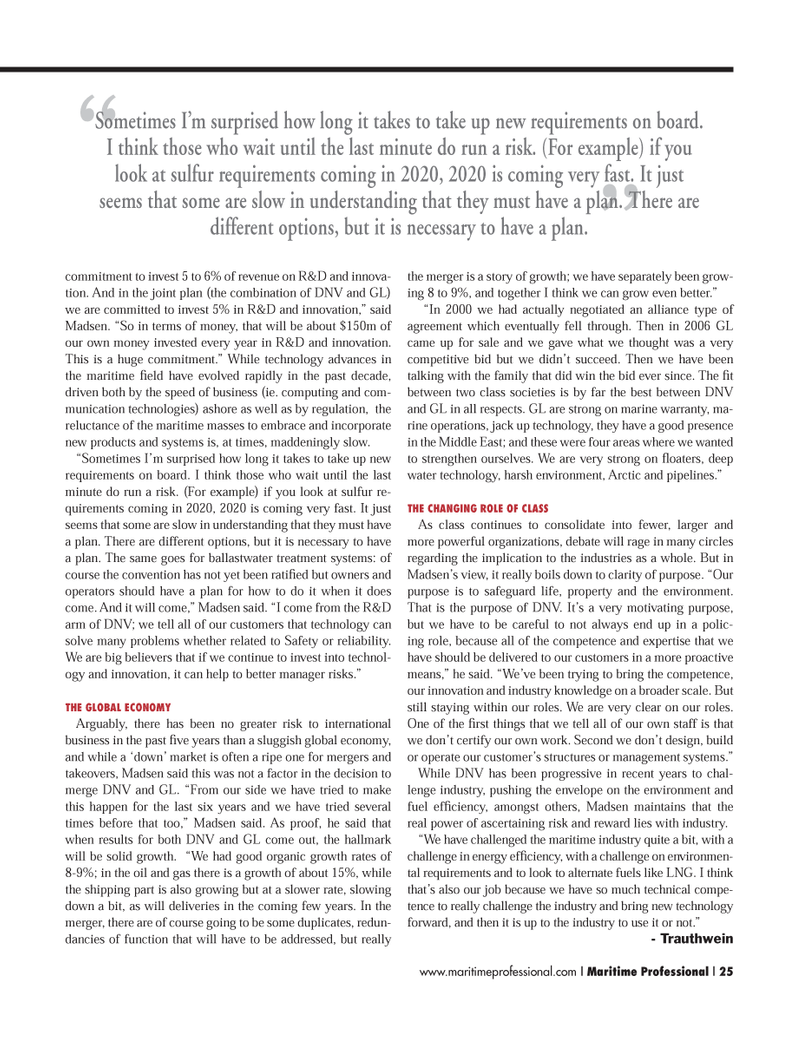
Page 25: of Maritime Logistics Professional Magazine (Q1 2013)
Maritime Risk
Read this page in Pdf, Flash or Html5 edition of Q1 2013 Maritime Logistics Professional Magazine
commitment to invest 5 to 6% of revenue on R&D and innova- tion. And in the joint plan (the combination of DNV and GL) we are committed to invest 5% in R&D and innovation,? said Madsen. ?So in terms of money, that will be about $150m of our own money invested every year in R&D and innovation. This is a huge commitment.? While technology advances in the maritime eld have evolved rapidly in the past decade, driven both by the speed of business (ie. computing and com- munication technologies) ashore as well as by regulation, the reluctance of the maritime masses to embrace and incorporate new products and systems is, at times, maddeningly slow. ?Sometimes I?m surprised how long it takes to take up new requirements on board. I think those who wait until the last minute do run a risk. (For example) if you look at sulfur re- quirements coming in 2020, 2020 is coming very fast. It just seems that some are slow in understanding that they must have a plan. There are different options, but it is necessary to have a plan. The same goes for ballastwater treatment systems: of course the convention has not yet been rati ed but owners and operators should have a plan for how to do it when it does come. And it will come,? Madsen said. ?I come from the R&D arm of DNV; we tell all of our customers that technology can solve many problems whether related to Safety or reliability. We are big believers that if we continue to invest into technol- ogy and innovation, it can help to better manager risks.? THE GLOBAL ECONOMY Arguably, there has been no greater risk to international business in the past ve years than a sluggish global economy, and while a ?down? market is often a ripe one for mergers and takeovers, Madsen said this was not a factor in the decision to merge DNV and GL. ?From our side we have tried to make this happen for the last six years and we have tried several times before that too,? Madsen said. As proof, he said that when results for both DNV and GL come out, the hallmark will be solid growth. ?We had good organic growth rates of 8-9%; in the oil and gas there is a growth of about 15%, while the shipping part is also growing but at a slower rate, slowing down a bit, as will deliveries in the coming few years. In the merger, there are of course going to be some duplicates, redun- dancies of function that will have to be addressed, but really the merger is a story of growth; we have separately been grow- ing 8 to 9%, and together I think we can grow even better.? ?In 2000 we had actually negotiated an alliance type of agreement which eventually fell through. Then in 2006 GL came up for sale and we gave what we thought was a very competitive bid but we didn?t succeed. Then we have been talking with the family that did win the bid ever since. The t between two class societies is by far the best between DNV and GL in all respects. GL are strong on marine warranty, ma- rine operations, jack up technology, they have a good presence in the Middle East; and these were four areas where we wanted to strengthen ourselves. We are very strong on oaters, deep water technology, harsh environment, Arctic and pipelines.? THE CHANGING ROLE OF CLASSAs class continues to consolidate into fewer, larger and more powerful organizations, debate will rage in many circles regarding the implication to the industries as a whole. But in Madsen?s view, it really boils down to clarity of purpose. ?Our purpose is to safeguard life, property and the environment. That is the purpose of DNV. It?s a very motivating purpose, but we have to be careful to not always end up in a polic- ing role, because all of the competence and expertise that we have should be delivered to our customers in a more proactive means,? he said. ?We?ve been trying to bring the competence, our innovation and industry knowledge on a broader scale. But still staying within our roles. We are very clear on our roles. One of the rst things that we tell all of our own staff is that we don?t certify our own work. Second we don?t design, build or operate our customer?s structures or management systems.? While DNV has been progressive in recent years to chal- lenge industry, pushing the envelope on the environment and fuel ef ciency, amongst others, Madsen maintains that the real power of ascertaining risk and reward lies with industry. ?We have challenged the maritime industry quite a bit, with a challenge in energy ef ciency, with a challenge on environmen- tal requirements and to look to alternate fuels like LNG. I think that?s also our job because we have so much technical compe- tence to really challenge the industry and bring new technology forward, and then it is up to the industry to use it or not.? - Trauthwein ??Sometimes I?m surprised how long it takes to take up new requirements on board. I think those who wait until the last minute do run a risk. (For example) if you look at sulfur requirements coming in 2020, 2020 is coming very fast. It just seems that some are slow in understanding that they must have a plan. There are different options, but it is necessary to have a plan. www.maritimeprofessional.com | Maritime Professional | 25MP #1 18-33.indd 25MP #1 18-33.indd 252/25/2013 3:03:46 PM2/25/2013 3:03:46 PM

 24
24

 26
26
